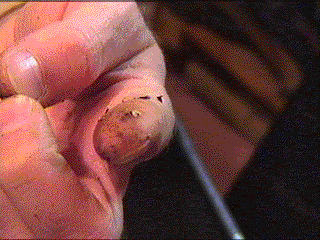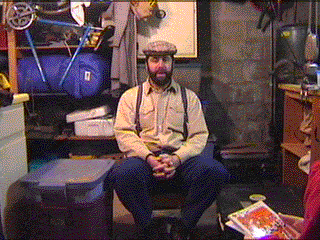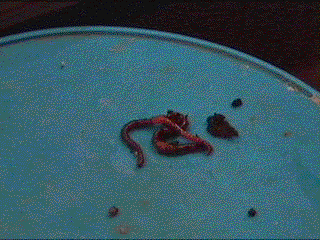Al's Vermi-Composting
article by Jessie R.
website by Jimmy K.
A wet musty smell
filled the basement. Plastic tubs filled with dirt were stacked to the ceiling.
Al Magnusson was wearing a brown shirt with blue suspenders. He held his hands
up for us to see.
 "Baby worms hatch from eggs.
They are almost microscopic. They are actually transparent. If you looked
under a microscope you could see the blood racing through their bodies. That
is why they’re called red wigglers."
"Baby worms hatch from eggs.
They are almost microscopic. They are actually transparent. If you looked
under a microscope you could see the blood racing through their bodies. That
is why they’re called red wigglers."
The tiny worm in
Al’s hand was only one of the millions he has raised in Al Magnusson's
vermi-composts. The word vermi is Italian for worm. Al uses
worms for composting. These worms are kept in systems, plastic tubs filled
with bedding material such as leaves and newspapers. He feeds the worms apple
cores, banana peels, pizza crusts and other table scraps. The worms grow,
reproduce, and digest the Magnusson’s leftovers through the winter. In the
spring a rich fertilizer of worm waste is ready for use in their garden.
It doesn’t smell
like cow manure and is organic, unlike store bought fertilizers. The
fertilizer helps the garden grow.
"Every year we get
these huge tomatoes." As Al describes them they are more the size of grapefruits
than your average garden tomato. Once started a system requires about
ten minutes a week to clean. Vermi-composting is environmentally friendly and
educational. Al started vermi-composting back in 1990.
minutes a week to clean. Vermi-composting is environmentally friendly and
educational. Al started vermi-composting back in 1990.
"I got this thing
in the mail from the Governor’s Recycling Council of New Hampshire. They
were trying to get teachers involved in classroom recycling and conservation."
Al explained.
Al explained that
they offered him a starting kit for vermi-composting that contained
a tub for the worms to live in and a handful of worms(about a thousand).
Ten years later,  Al has had over 55 systems and has sold and given away systems, including
the one he gave us. Once he had a "worm party", and everyone who came went
away with worms of their own. He also sacrifices some of his worms to neighborhood
kids when they go fishing.
Al has had over 55 systems and has sold and given away systems, including
the one he gave us. Once he had a "worm party", and everyone who came went
away with worms of their own. He also sacrifices some of his worms to neighborhood
kids when they go fishing.
Al is enthusiastic
about vermi-composting and impressed us with his knowledge of worms.
He raises two types
of worms:Red wigglers and earthworms. Red wigglers’ scientific name is Eisnia
foetida. Earthworms are Lumbricus rubellus. Worms hate light. They like damp,
dark places. They need air, a common temperature, and food. Red wigglers
suck their food in. Earth worms scoop food in with their upper lip. Worms
can’t see so they depend heavily on their hearing.Worms are hermaphrodites
but they need to mate to reproduce. All in all, worms  are fascinating creatures.
are fascinating creatures.
Al has other environmental
hobbies. He does outdoor composting along with the vermi-composting.
He has organic vegetable gardens and several flower beds. He also enjoys
many outdoor activities. He camps and hikes. Al is Sanborn high school's
varsity soccer coach and each year he takes his team rock climbing.
Al is a Sanborn alumni
and teaches seventh grade science in Hampton. He writes a comic strip for
the Carriage Town News. Al lives in Kingston with his wife, Mary, and
two children, Hannah and Jed.
Oh yeah- he does
great worm impressions.
|